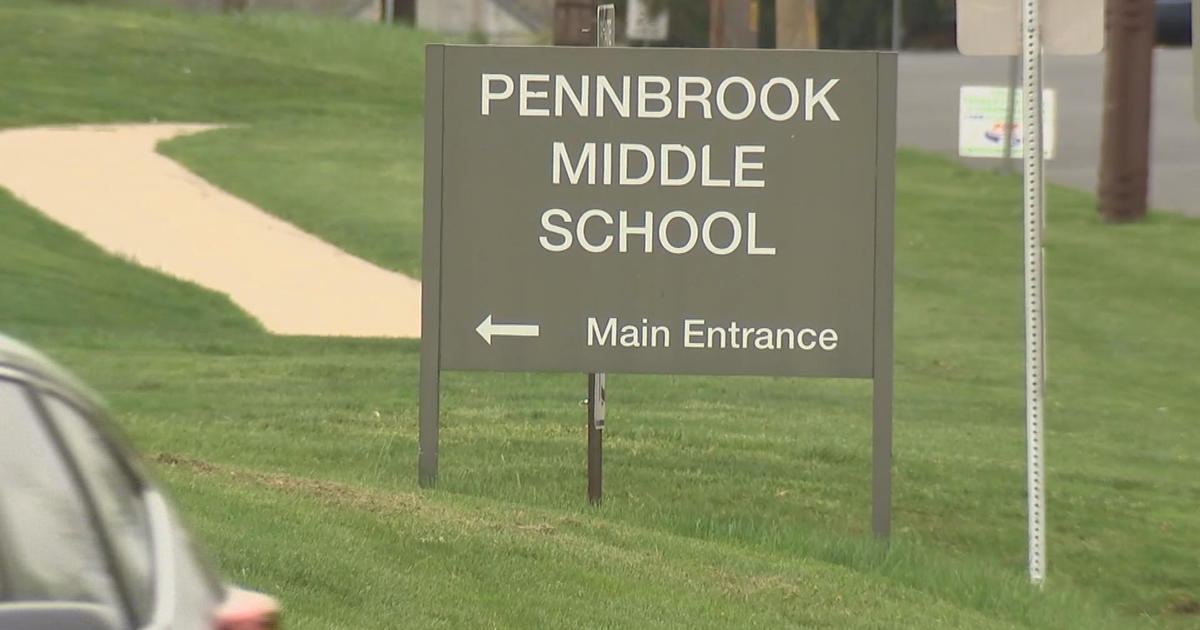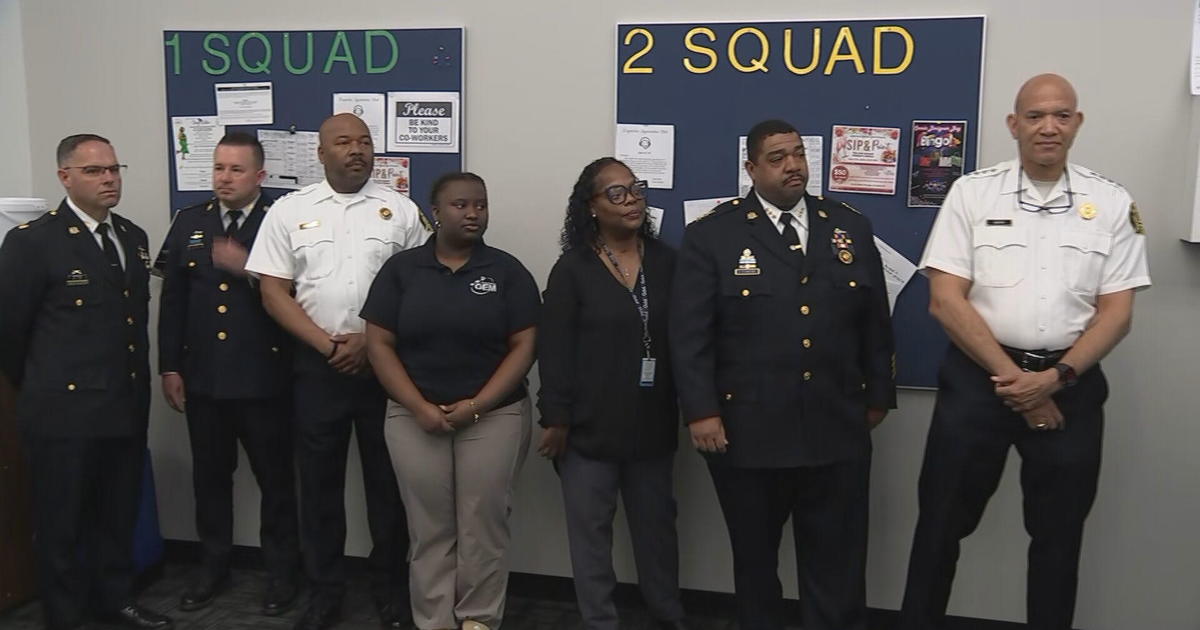Succeeding Through Adversity
By Joseph Santoliquito
PHILADELPHIA (CBS) — Kim Spiegel sat there at the family dinner table a little on edge. She had been pondering the thought for some time and nervously waited for the right moment to spring the question on her father. How to put it, she kept thinking to herself, fearful of her father's reaction.
She came well-armed, prepared for all her father's anticipated objections. Finally, the notion that had been stirring there arose and she blurted it out.
"Dad, I want to wrestle," she said. Her father replied bluntly, emphatically, "No!"
Kim wasn't going to be deterred. She wouldn't accept that answer. It took a few days, and her father Paul to do some research on the subject, before being whittled down and agreeing to permit his daughter to wrestle for her grade school team.
Now Paul doesn't miss a match. And Kim, now a freshman at West Chester University (West Chester, Pa.), went on to become a two-time national champion and trained at the Unites States Olympic Education Center, in Marquette, Mich., her senior year of high school at Selinsgrove (Pa.).
There are a growing number of girls across the country sitting at their evening dinner tables primed to ask the same life-altering question to their parents as Kim did. Womens wrestling became an Olympic sport in 2004, and according to the National Federation of State High School Associations (NFHS) 2010-11 participation survey, girls wrestling is the fastest-growing sport for high school girls (in terms of percentage increase).
In its 2010-11 release, the NFHS High School Athletics Participation Survey stats revealed there were 273,732 boys competing in wrestling, an increase of 842 wrestlers from the previous year (0.3 percent increase). Girl high school wrestlers grew to 7,351 athletes, an increase of 1,217 wrestlers from the previous year (a 19.8 percent increase).
Five states hold high school-sanctioned championships: Washington, Hawaii, California, Texas, and Massachusetts. The best high school girls wrestlers come from Texas and California. This year, Pennsylvania, one of the country's top wrestling states, held its first USA Wrestling-sanctioned all-girls state championship. The event attracted 178 female wrestlers from middle school and high school the weekend of March 11 at Susquehanna Township High School (Harrisburg, Pa.), hosted by the Pennsylvania Amateur Wrestling Federation.
"The sport has grown tremendously," said Jen Chu, 27, a graduate student who is the Pennsylvania director for womens wrestling and the club coach for Women Only Wrestling, which put on the Pennsylvania event. "In high school, I was allowed to practice with my team, but I couldn't compete, even after I beat the boy at 119 in a wrestle-off. But I had that satisfaction. I never received a varsity letter and it still bothers me today.
"I'm trying to correct an injustice that was done to me. When girls wrestling gets media attention, it's when a girl beats a boy. My goal is to have something completely separate from the boys and establish girls wrestling. The answer is to separate girls and boys wrestling, and the way to expand the sport is to separate it."
Chu had to overcome some stigmas associated with womens wrestling. It is a real sport. The United States, Japan, Canada and China are the best countries in the world for womens wrestling. Yet there is a stereotype these young women sometimes have to push through to get the message across that it is a real sport.
"If you google womens wrestling, all of these (adult) sites come up," Chu said, with a slight laugh. "Wrestling, boys or girls, is a misunderstood, marginalized, on-the-edge sport. If I'm out socially, and wrestling is such a huge part of who I am, I tell people what I'm associated with. Believe it or not, I have been asked jello, mud, what is it? Womens wrestling is an Olympic sport. Even as womens wrestling is growing, it's still really misunderstood."
The ironic twist is that girls high school wrestling is far more organized and accepted at the national level in the United States than it is at the grassroots level, where girls are first introduced to the sport.
* * *
Many high school girls get introduced to the sport the way Kim Spiegel did: Their brothers or a family member wrestled. What stirred Kim was watching her older brother Greg wrestle. She'd sit there at the meets when she was 8 years old with pom-poms in her hands cheering him on, not really knowing what was happening.
"I was more interested in getting peanut butter cups than watching," Kim said laughing. "But as I got older, it's something I always to at least try. My brothers wrestled for 10 years and that's what got me interested in it. I started my freshman year on the boys team at Selinsgrove.
"I had had it pretty good. There were other girls on the team, so it wasn't a shock. The sport is definitely growing larger, especially in Pennsylvania. We've had more girls go to nationals than ever before. There are more opportunities for girls to compete in international events. Though I've seen some things once or twice of girls stopping because of peer pressure, there is more acceptance today of high school girls wrestling."
Today, Kim is one of the better collegiate wrestlers in the country.
* * *
Kaitlin Fitzpatrick is a 5-foot-2, 95-pound ball of dynamite. The sophomore at Pennsbury (Fairless Hills, PA) is built more like a gymnast. She just won the 101-pound national championship, but she didn't start wrestling until seventh grade — on a dare by a friend.
"I showed up for wrestling and I started messing around knowing absolutely nothing about what I was doing, and my friend couldn't believe it," Fitzpatrick recalled.
The funny thing was Fitzpatrick did well against seasoned kids her own age. Experienced boys. The coach pulled her aside and showed her some basic moves. The following day, she came back.
"I think that's what shocked everyone, that I did come back," she said. "But I liked it. Everyone was amazed I came back the next day. When I started beating people within a couple of weeks, it's when I started noticing the boys would shy away from me. They felt threatened. I went through a lot. It took a while but I realized I didn't need to push through; I just had to find someone to support me.
"My freshman year at Pennsbury, I tried out for the team and beat this one kid and the coach pulled me aside and told me not to come back again. But I wasn't going to give up and I wanted to stick it out.
The coach put me up against bigger, more experienced kids. It was really tough mentally, because you realize you're not wanted there by everyone. I just want to wrestle. I love training. I love competing. I just love wrestling and I love getting better."
Pete Fitzpatrick, Kait's father, wrestled in high school. He supported his daughter's decision to wrestle, and found Chu and her club program, as well as a local program run by Council Rock South High School coach Brad Silimperi.
"As a dad, I'm 110-percent behind her, and Kait has this tremendous drive, she loves competing and we get far more help and support at the national level than we do locally," Pete says. "We didn't want to press the matter Kait's freshman year at Pennsbury. But it wasn't a good environment.
"I do prefer Kait to wrestle against other girls. I watch her at these club workouts wrestling other boys and she holds her own. She's developing the techniques and constantly learning. All we ask is for a chance. But every girl and every girl's parent have dealt with some kind of adversity with the sport. I do see it changing from these top-level clubs. I see some dads get a little ruffled when a girl puts their son on their backs. My family and I have been involved four years with the sport, and we're going to be involved a lot longer with Kait. I see more changes evolving. For Kait, she's a sophomore and young enough to grow and compete at a higher level and be seen by colleges."
Right now, there are about 20 colleges that offer womens wrestling. In two years time, Pete Fitzpatrick feels, there could be 30 college womens wrestling programs.
Terry Steiner, the U.S. Womens National Wrestling Team coach, has made a point to work with his female wrestlers like he was coaching men. He's seen what was once glacial movement in high school girls wrestling, transform into more rapid changes in recent years.
"It is the fastest-growing sport at the high school level," said Steiner, a three-time All-American at Iowa. "I think a lot of the growth is because there are coaches out there that are willing to give these girls a chance. Different states are going about sanctioning and growth in different ways. In Texas, they started womens wrestling when they sanctioned boys wrestling, which isn't that long. I'd say that happened in the early- to mid-1990s. I would say Texas is the leader in what they've done. We're building this thing from the top down, and it's because of the Olympics. It's been a real credit to the women, because they had to fight through systems, coaches and parents to survive in this sport. They've been strong-minded and it's why there has been growth.
"I hear coaches say this all of the time, they're not really comfortable with girls in the room. I counter that these coaches are supposed to be educators and they're supposed to be teaching and coaching these kids, no matter what. The sport is a great sport and you'll hear everyone say it's helped their lives. Why limit that opportunity to half the population and why not use wrestling to teach life lessons? These coaches need to step outside and ask why they do what they do. Why should it make a difference whether it is a boy or girl in front of them? It's a sport for everyone."
As the number of states grows for all-girls, state-sanctioned high school championships, more opportunities blossom for wrestlers like Kait Fitzpatrick. The Pennsylvania state tournament provided the kind of high-level competition she needed to compete at the national level.
Chu has the support of USA Wrestling, the national governing body of the sport. She's trying to get the Pennsylvania Interscholastic Athletic Association (PIAA), Pennsylvania's high school governing body, on board. That's been the battle — the national support over state sanctioning high school organizations.
"It's exactly what I'm trying to do," Chu said. "My state tournament was sanctioned by USA Wrestling. The growth is occurring with girls wrestling other girls. There are talented girls that can compete with the boys, but those are rare. The future is state-sanctioned all-girls tournaments. It's the direction, I feel, everyone would agree the sport has to go."
Kait Fitzpatrick brings up some valid points: More girls need to be introduced to the sport at a younger age, and though the sport is growing exponentially, it's only because younger coaches are allowing girls to compete for their high school teams.
"If there weren't any coaches under the age of 30, I wouldn't be where I am," Kait says. "My coach my freshman year at Pennsbury was older and there was no way he was going to have a girl on his team. It's why I think the state tournament was huge. Girls are showing they can wrestle. Other girls see this and they can do it, too. I would rather wrestle against girls than boys because it is much fairer. But you have to be a special kind of person to be a female wrestler, because of all of the things you have to go through.
"You have to learn on your own. It's a very odd situation. Support doesn't come at the grassroots level. There are definitely still barriers that need to be broken. If I wasn't dared in seventh grade, I wouldn't be wrestling. And I'll be honest, I'm thinking about trying out for my high school team next year. My dream one day is to wrestle in the Olympics."
Wrestling in the Olympics. It's certainly not a topic many high school female athletes would broach 10 years ago sitting at the family dinner table.
It is now.




